- favorite go
- Top Menu go
- Main Content go
- Copyright go


TrueBeam STx
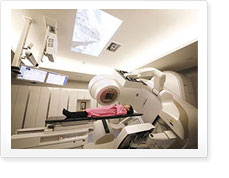 Cutting edge radiotherapy equipment, TrueBeam STx
Cutting edge radiotherapy equipment, TrueBeam STx
- 4 dimensional radiotherapy equipment that accurately and precisely executes treatment in a short period of time while leaving normal cells intact
- First to introduce the equipment in the Chungcheong and Honam regions... High level cancer treatment benefits are anticipated through introduction of the latest medical equipment for local cancer patients
TrueBeam STx, the latest radiotherapy equipment
Although radiotherapy was used in the past mostly as an auxiliary treatment to alleviate symptoms or for post-surgical recurrence of terminal-stage cancer, it has been developed to the extent of being used for treatment at the level same as cancer surgery, through the rapid advancement of medical equipment technologies.
The TrueBeam STx that our hospital has introduced is 4-dimensional radiotherapy equipment that minimizes the side effects of existing radiotherapy by preventing exposure to unnecessary irradiation to normal cells at the time of irradiation during cancer treatment.
TrueBeam STx is considered to be the best existing equipment for maximizing treatment effects and minimizing side effects, and achieves this by markedly reducing treatment time through its high dose output, which is more than 4 times the intensity of existing radiotherapy equipment, and by enabling accurate and precise treatment.
In particular, it is capable of substantially reducing the radiation dose within normal tissue with an error range of less than 1mm, and performs efficient radiotherapy without limitations to the depth or location of the tumor treated since it is possible to select a diverse range of radiation energy.
In addition, TrueBeam is innovative radiotherapy equipment that provides the best radiotherapy effects to patients by systematically linking together the entire process of radiotherapy including image acquisition, patient posture compensation, tumor movement, and radiation delivery, etc.
Since it is capable of observing and treating the movement of the tumor due to the breathing of the patient in real time, it is able to maximally preserve normal tissue even during treatment for lung cancer and liver cancer, etc. Moreover, it is able to produce further improved treatment effects by providing a stable and comfortable treatment environment through a triple-interlinked TV monitoring system, since it is designed from the perspective of the patient.
Da Vinci S
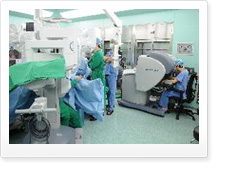 The most advanced robotic surgical equipment, Da Vinci S
The most advanced robotic surgical equipment, Da Vinci S
Da Vinci S surgical equipment is recently in the limelight due to the performance of a minimally invasive surgery. Da Vinci S, introduced at the Jeonbuk national university hospital, uses a special camera that shows surgical sites enlarged up to 15 times in 3D, so minute, elaborative operations are possible. The robot arm, which can rotate freely up to 540 degrees, is operated by remote control. It guarantees safe surgery without hand tremors. In addition, scarring is rare due to non-laparotomy surgery, with fast recovery after surgery and minimized possibility of complications cited as advantages.
The application of Da Vinci S
Da Vinci S is useful in various areas of surgery, especially for prostate, which is difficult to remove with human hands. Moreover, it is applied in cardiac disorders such as cardiac septal defect or mitral valve disease, and thyroid cancer which frequently leaves scarring . Also, it is broadly applied in minute surgeries such as cervical cancer, endometrial cancer, ovarian cancer, and in gynecologic and obstetric diseases such as uterine myoma, hysterectomy, Fallopian tube abscess [cancer], various ovarian surgeries, ectopic pregnancy, and Fallopian tube repair. Surgery for gastric cancer, esophageal cancer, and colorectal cancer are also performed.
IGRT
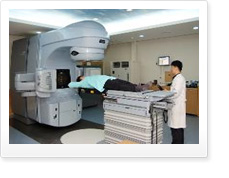 Minimizing damage of regular tissues ??the advanced medical device Image Guided Radiation Therapy (IGRT)
Minimizing damage of regular tissues ??the advanced medical device Image Guided Radiation Therapy (IGRT)
Radiotherapy methods are developed to increase the success of cancer treatments and minimize the amount of radiation around the regular tissue. As a result of the medical study , the new radiotherapy system, IGRT system, using a linear accelerator, was developed. IGRT system introduced at the Jeonbuk National University Cancer Center checks the images from CT, MRI, and PET in real time, so minute high-dose radiation therapy is used only for cancer cells and the side effects can be minimized in the regular tissues. An image information system is utilized for treatment accuracy and real time confirmation during radiotherapy. The shape and location of cancer cells and the environs of normal organs can be observed in 3D because real time confirmation is possible by the images from medical devices such as CT.
4D radiotherapy is also possible, tracing the movement of cancer cells followed by respiration and confirming the location of the target as it is equipped with real-time position management (RPM). Therefore, safe therapy is practicable due to calculation of patient?? respiration. IGRT system provides precise intensity of radiation by the size of cancer cell, so complicated cancers can be cured safely.
MRI 3.0 Tesla
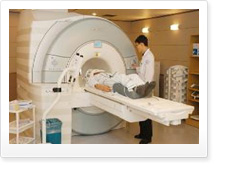 3.0T MRI for a more rapid and accurate diagnosis
3.0T MRI for a more rapid and accurate diagnosis
The Jeonbuk National University Hospital begins the use of 3.0T MRI in the Jeonbuk province. MRI introduced at the Jeonbuk National University Hospital is ??AGNETOM Verio 3T+70cm+Tim?? alias ??erio??developed by SIMENS, Germany. The great benefit of 3.0T MRI is short scanning time and high resolution images as compared to 1.5T MRI. It provides a70cm wider magnet bore, which is a cylinder for the examination of patients, so patients with claustrophobia feel more comfortable. More accurate diagnosis has become possible for the head (including the brain), the backbone and the knee, and for moving infants who lack concentration.
Possible diagnoses by 3.0T MRI
3.0T MRI is very useful for the diagnosis of brain diseases and cardiac disorders. With the latest 3.0T MRI, fast image scanning is applied to the images of the coronary arteries, myocardial changes, and vascular evaluation. Micro-bleeding can be found in the cranium in cases of brain disease. 3.0T MRI provides precise information for arteriovenous malformation.
Scanning the whole body in only one checkup
??erio??can scan the whole body in only one checkup. This the big difference from existing MRI which scan partial sites. Therefore, metastasis and systemic progress of cancer can be examined in only one checkup. Various examinations are possible such as full spine imaging, pediatric high-resolution imaging, fine cerebrovascular imaging, breast imaging, brain scan before the brain tumor surgery, cerebral blood flow scan, magnetic resonance spectroscopy, etc.
PET-CT
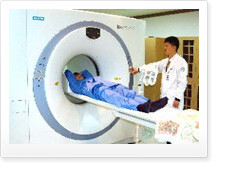 The spearhead for the cancer diagnosis,PET-CT
The spearhead for the cancer diagnosis,PET-CT
PET-CT was introduced first in Jeonbuk at the Jeonbuk National University Hospital in April, 2005. The latest 40-channel PET-CT was also introduced. PET-CT is imaging equipment: PET (Positron Emission Tomography) and CT (Computed Tomography). A fusion of PET and CT imaging, it is the most advanced medical equipment in nuclear medicine technology. PET images show human metabolic abnormalites, and CT images provide detailed anatomical information. Therefore, it has become easier to find the location and track metabolic changes in lesions. In making an early diagnosis of cancer PET-CT scans release positrons from the body which has been injected with F-18 FDG (radiopharmaceuticals).
Practical use of PET-CT
PET-CT is useful for the early diagnosis of various cancers (including 5mm sizes) due to whole body scanning. Moreover, it helps to find the range of metastasis accurately and decide the curative treatment plan, and possibility of recurrence. PET-CT provides the exact location of a cancer in the case of biopsy. It is also important in helping to decide the optimum amount of radiation under radiotherapy. PET-CT can scan the brain metabolism, so the early diagnosis of dementia in neurological disorders is possible and the cause of dementia can be decided. It can be broadly used in cardiovascular diseases and psychiatric disorders.
Dual Source Computed Tomography(DSCT)
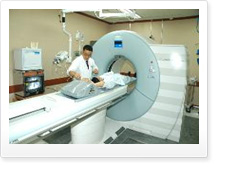 DSCT exhibits a high diagnostic ability in regards to cardiac and cerebrovascular diseases,
DSCT exhibits a high diagnostic ability in regards to cardiac and cerebrovascular diseases,
The big difference in DSCT scan as compared with established CT the use of two tubes rather than one tube in the diagnosis of various diseases. The introduction of DSCT is a great development in the diagnosis of various vascular diseases including cardiac and cerebrovascular diseases. It makes a faster, more accurate diagnosis particularly in emergency cases. Effective early treatment for cardiac and cerebrovascular diseases with high mortality rates has become possible due to DSCT. Experts have said that DSCT is safer for patients as radiation exposure amounts remarkably decrease.
Established equipment is limited to scan the three coronary arteries related to angina pectoris and myocardial infarction. Fast and irregular heartbeats make artifacts on the image and at times causing wrong diagnosis, so scanning was only possible when the heartbeat was reduced to less than 60 beats/min after the administration of a drug.
However, with the new high-tech DSCT, we can obtain very clean images for all heartbeats as the two tubes rotate concurrently. It is very useful for the diagnosis of cardiac disorders. It helps our patients visiting the Jeonbuk National University Hospital to live a better, longer life through the early diagnosis for acute myocardial infarctions or strokes.
Gamma knife
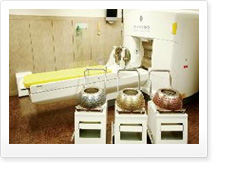 Gamma knife, the beginning of bloodless brain surgery in Jeonbuk province
Gamma knife, the beginning of bloodless brain surgery in Jeonbuk province
Gamma knife is a bloodless brain surgery equipment, for treating brain tumors without opening the head. The gamma knife uses gamma rays from Cobalt 60, an isotope, to treat brain tumors or vascular malformations. It is the same as looking at lesions through a magnifying glass. 201 radial rays are shot into the lesion with minimum effect to the regular tissues. The gamma knife can be applied in cases of a tumor in the medulla or in surgery with the risk of neurological disorders,.There is no need to shave the hair, subject a patient to general anesthesia, or take pain-killers or antibiotics, so the patient can return to daily life immediately after the gamma knife operation.
The application of gamma knife
- Tumors; primary brain tumors, metastatic tumors, meningioma, acoustic schwannoma, pituitary adenoma,
craniopharyngioma, pineal gland tumor, vascular tumors, etc.
- Vascular malformation; cerebral arteriovenous malformation, etc.
- Functional brain disease; epilepsy, Parkinson´s disease, trigeminal neuralgia, cancer pain that is not
controlled by drugs.
- Psychiatric disorders; obsession, depression.
Prostate laser instrument
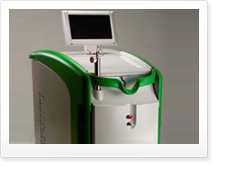 HPS prostate laser instrument is to treat for benign prostate hypertrophy with little bleeding. It is safe for the high risk patients and persons who take anticoagulants.
HPS prostate laser instrument is to treat for benign prostate hypertrophy with little bleeding. It is safe for the high risk patients and persons who take anticoagulants.
MEDICAL CARE
MEDICAL CARE
 Cutting edge radiotherapy equipment, TrueBeam STx
Cutting edge radiotherapy equipment, TrueBeam STx The most advanced robotic surgical equipment, Da Vinci S
The most advanced robotic surgical equipment, Da Vinci S Minimizing damage of regular tissues ??the advanced medical device Image Guided Radiation Therapy (IGRT)
Minimizing damage of regular tissues ??the advanced medical device Image Guided Radiation Therapy (IGRT) 3.0T MRI for a more rapid and accurate diagnosis
3.0T MRI for a more rapid and accurate diagnosis The spearhead for the cancer diagnosis,PET-CT
The spearhead for the cancer diagnosis,PET-CT DSCT exhibits a high diagnostic ability in regards to cardiac and cerebrovascular diseases,
DSCT exhibits a high diagnostic ability in regards to cardiac and cerebrovascular diseases, Gamma knife, the beginning of bloodless brain surgery in Jeonbuk province
Gamma knife, the beginning of bloodless brain surgery in Jeonbuk province HPS prostate laser instrument is to treat for benign prostate hypertrophy with little bleeding. It is safe for the high risk patients and persons who take anticoagulants.
HPS prostate laser instrument is to treat for benign prostate hypertrophy with little bleeding. It is safe for the high risk patients and persons who take anticoagulants.

 favorite site
favorite site

